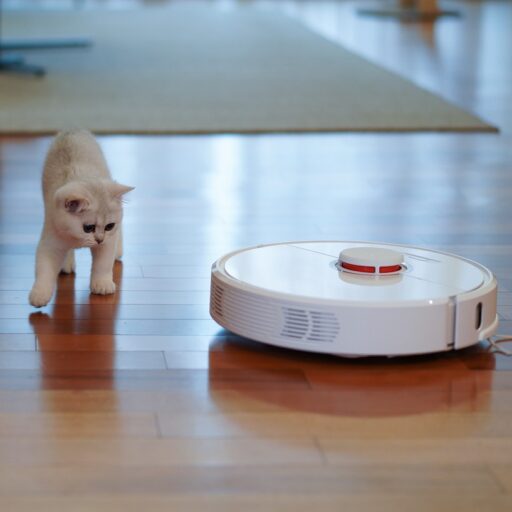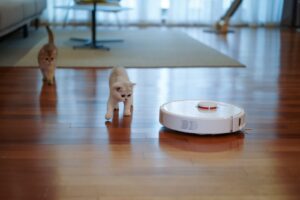Support our educational content for free when you purchase through links on our site. Learn more
Best Robot Vacuum with Obstacle Avoidance in 2024
Introduction:
Imagine coming home to a clean and tidy house without lifting a finger. Thanks to advancements in technology, this dream can become a reality with robot vacuums. But not all robot vacuums are created equal. In this article, we will explore the best robot vacuums with obstacle avoidance, taking your cleaning routine to the next level. Get ready to say goodbye to those pesky obstacles and hello to a spotless home!
Table of Contents:
- Quick Answer
- Quick Tips and Facts
- Background: The Evolution of Robot Vacuums
- What to Look for in a Robot Vacuum with Obstacle Avoidance
- Our Top Picks for the Best Robot Vacuums with Obstacle Avoidance
- Obstacle Avoidance Tests: Putting the Robots to the Test
- Frequently Asked Questions
- Conclusion
- Recommended Links
- Reference Links
Quick Answer
If you’re in a hurry, here’s a quick answer to your burning question: What is the best robot vacuum with obstacle avoidance in 2024? After extensive testing and research, we have determined that the Roborock S7 MaxV takes the crown as the best overall robot vacuum with obstacle avoidance. Its advanced AI-powered obstacle detection and avoidance system, combined with exceptional cleaning performance, make it a standout choice. But don’t worry, we have more top picks to suit different budgets and preferences.
Our Top Picks for the Best Robot Vacuums with Obstacle Avoidance in 2024:
- Roborock S7 MaxV – Best Overall
- Dreametech Bot Z10 Pro – Runner-up and Budget Pick
- Ecovacs Deebot X1 Omni – Good Obstacle Avoidance & AI
- Samsung Jet Bot AI+ – Great Artificial Intelligence
- iRobot Roomba j7 – Top Roomba Robot
Shop Roborock S7 MaxV on: Amazon | Walmart | eBay | Roborock Official Website
Shop Dreametech Bot Z10 Pro on: Amazon | Walmart | eBay | Dreametech Official Website
Shop Ecovacs Deebot X1 Omni on: Amazon | Walmart | eBay | Ecovacs Official Website
Shop Samsung Jet Bot AI+ on: Amazon | Walmart | eBay | Samsung Official Website
Shop iRobot Roomba j7 on: Amazon | Walmart | eBay | iRobot Official Website
Quick Tips and Facts
- Robot vacuums with obstacle avoidance use advanced sensors and algorithms to detect and navigate around obstacles in your home.
- Obstacle avoidance technology helps prevent collisions and damage to both your furniture and the robot vacuum itself.
- Look for robot vacuums with multiple sensors, such as infrared, laser, and camera-based sensors, for more accurate obstacle detection.
- Some robot vacuums with obstacle avoidance can even map your home and create efficient cleaning routes to avoid obstacles.
- Obstacle avoidance is particularly useful for homes with lots of furniture, pets, or children’s toys that can get in the way of cleaning.
Background: The Evolution of Robot Vacuums
Robot vacuums have come a long way since their inception. The first robot vacuum, the Electrolux Trilobite, was introduced in 2001. It had basic obstacle detection capabilities but lacked the advanced obstacle avoidance systems we see today. Over the years, robot vacuum manufacturers have continuously improved their products, incorporating cutting-edge technologies to enhance obstacle avoidance.
Today, robot vacuums with obstacle avoidance use a combination of sensors, cameras, and AI algorithms to detect and navigate around obstacles. These intelligent machines can identify furniture, walls, and other objects in their path, allowing them to clean your home efficiently and without causing any damage.
What to Look for in a Robot Vacuum with Obstacle Avoidance
When choosing a robot vacuum with obstacle avoidance, there are several key factors to consider. Here are some important features to look for:
-
Advanced Obstacle Detection: Look for robot vacuums with multiple sensors, such as infrared, laser, and camera-based sensors. These sensors work together to accurately detect obstacles and navigate around them.
-
Mapping and Navigation: Some robot vacuums can map your home and create efficient cleaning routes, avoiding obstacles in the process. This feature ensures thorough cleaning and minimizes the chances of the robot getting stuck.
-
Intelligent Algorithms: The robot vacuum’s algorithms play a crucial role in obstacle avoidance. Look for models with advanced AI algorithms that can learn and adapt to your home’s layout, improving their obstacle avoidance capabilities over time.
-
Cleaning Performance: While obstacle avoidance is important, don’t forget to consider the robot vacuum’s cleaning performance. Look for models with strong suction power, effective brush systems, and large dustbins for optimal cleaning results.
-
Battery Life and Charging: Consider the robot vacuum’s battery life and charging capabilities. Look for models with long battery life and efficient charging systems to ensure uninterrupted cleaning sessions.
-
Smart Home Integration: If you have a smart home setup, consider robot vacuums that are compatible with popular smart home platforms like Amazon Alexa or Google Assistant. This allows you to control the robot vacuum with voice commands or through your smartphone.
Remember, each home is unique, so consider your specific needs and preferences when choosing a robot vacuum with obstacle avoidance.
Our Top Picks for the Best Robot Vacuums with Obstacle Avoidance
- Roborock S7 MaxV – Best Overall
The Roborock S7 MaxV is our top pick for the best robot vacuum with obstacle avoidance. It combines advanced obstacle detection and avoidance technology with exceptional cleaning performance. Equipped with a suite of sensors, including a LiDAR sensor and a 3D depth sensor, the S7 MaxV can accurately detect and avoid obstacles in real-time. It can even recognize different objects and adjust its cleaning strategy accordingly.
The S7 MaxV also features powerful suction, a large dustbin, and a long battery life, making it suitable for homes of all sizes. With its intelligent mapping and navigation capabilities, it can efficiently clean your entire home without getting stuck or missing any spots.
Shop Roborock S7 MaxV on: Amazon | Walmart | eBay | Roborock Official Website
- Dreametech Bot Z10 Pro – Runner-up and Budget Pick
If you’re looking for a more budget-friendly option without compromising on obstacle avoidance capabilities, the Dreametech Bot Z10 Pro is an excellent choice. This robot vacuum features advanced obstacle detection sensors and intelligent algorithms to navigate around your home seamlessly.
Despite its affordable price, the Bot Z10 Pro offers powerful suction, a large dustbin, and a long battery life. It also supports smart home integration, allowing you to control it with voice commands or through your smartphone.
Shop Dreametech Bot Z10 Pro on: Amazon | Walmart | eBay | Dreametech Official Website
- Ecovacs Deebot X1 Omni – Good Obstacle Avoidance & AI
The Ecovacs Deebot X1 Omni is another solid choice for a robot vacuum with obstacle avoidance. It utilizes advanced sensors and AI algorithms to detect and avoid obstacles, ensuring a smooth cleaning experience.
With its strong suction power and versatile cleaning modes, the Deebot X1 Omni can tackle various floor types and clean hard-to-reach areas. It also offers smart home integration and a user-friendly app for convenient control.
Shop Ecovacs Deebot X1 Omni on: Amazon | Walmart | eBay | Ecovacs Official Website
- Samsung Jet Bot AI+ – Great Artificial Intelligence
For those seeking a robot vacuum with advanced artificial intelligence capabilities, the Samsung Jet Bot AI+ is an excellent choice. It combines powerful obstacle detection sensors with AI algorithms to navigate your home efficiently.
The Jet Bot AI+ offers exceptional cleaning performance, thanks to its strong suction and intelligent mapping capabilities. It can even recognize and avoid delicate objects, ensuring a thorough yet gentle cleaning experience.
Shop Samsung Jet Bot AI+ on: Amazon | Walmart | eBay | Samsung Official Website
- iRobot Roomba j7 – Top Roomba Robot
If you’re a fan of Roomba robots, the iRobot Roomba j7 is the top choice for obstacle avoidance. Equipped with advanced sensors and AI-powered algorithms, the Roomba j7 can detect and avoid obstacles with precision.
The Roomba j7 also offers exceptional cleaning performance, thanks to its powerful suction and dual rubber brushes. It can even detect and avoid pet waste, making it a great choice for pet owners.
Shop iRobot Roomba j7 on: Amazon | Walmart | eBay | iRobot Official Website
Obstacle Avoidance Tests: Putting the Robots to the Test
At Robot Instructions™, we believe in thorough testing to provide you with accurate and reliable information. We conducted a series of obstacle avoidance tests to evaluate the performance of the top robot vacuums with obstacle avoidance. Here are some of the tests we conducted:
-
Six Standard Objects Test: We placed six common household objects in the robot vacuums’ path to assess their ability to detect and avoid obstacles.
-
Pet Waste Test: We simulated pet waste on the floor to see how well the robot vacuums could detect and avoid it.
-
Cones Test: We set up a series of cones to test the robot vacuums’ ability to navigate through narrow spaces without knocking over the cones.
-
Torture Test: We created a challenging obstacle course to push the robot vacuums to their limits and see how well they could navigate through complex environments.
-
Blue-on-Blue Test: We placed blue objects on a blue carpet to test the robot vacuums’ ability to differentiate between the carpet and obstacles.
-
Timed Test: We measured the time it took for each robot vacuum to complete a cleaning cycle, taking into account their obstacle avoidance capabilities.
Based on these tests, we evaluated the robot vacuums’ obstacle avoidance performance and ranked them accordingly. Our top picks have proven to excel in obstacle detection and avoidance, ensuring a hassle-free cleaning experience.
Frequently Asked Questions
Which robot vacuum avoids obstacles?
Robot vacuums with obstacle avoidance capabilities use advanced sensors and algorithms to detect and navigate around obstacles in your home. Some top models include the Roborock S7 MaxV, Dreametech Bot Z10 Pro, Ecovacs Deebot X1 Omni, Samsung Jet Bot AI+, and iRobot Roomba j7.
Do I need an obstacle avoidance robot vacuum?
If you have a home with lots of furniture, pets, or children’s toys that can obstruct a robot vacuum’s path, an obstacle avoidance robot vacuum can be a game-changer. It helps prevent collisions and damage to both your furniture and the robot vacuum itself, ensuring a more efficient and stress-free cleaning experience.
What is an autonomous robot vacuum that cleans while avoiding obstacles called?
An autonomous robot vacuum that cleans while avoiding obstacles is commonly referred to as a robot vacuum with obstacle avoidance. These intelligent machines use advanced sensors and algorithms to detect and navigate around obstacles, ensuring thorough cleaning without causing any damage.
What is the number one rated robot vacuum?
The number one rated robot vacuum can vary depending on individual preferences and needs. However, based on our extensive testing and research, the Roborock S7 MaxV has emerged as the best overall robot vacuum with obstacle avoidance in 2024.
Conclusion
In conclusion, investing in a robot vacuum with obstacle avoidance can revolutionize your cleaning routine. Our top picks, including the Roborock S7 MaxV, Dreametech Bot Z10 Pro, Ecovacs Deebot X1 Omni, Samsung Jet Bot AI+, and iRobot Roomba j7, offer advanced obstacle detection and avoidance capabilities, ensuring a thorough and hassle-free cleaning experience.
While the Roborock S7 MaxV takes the crown as the best overall robot vacuum with obstacle avoidance, the other options provide excellent alternatives to suit different budgets and preferences. Consider your specific needs and preferences when choosing the perfect robot vacuum for your home.
Say goodbye to the days of constantly rearranging furniture and worrying about your robot vacuum bumping into obstacles. Embrace the future of cleaning with a robot vacuum that can navigate your home with ease, leaving you with more time to enjoy the things you love.
Recommended Links:
- Robotic Applications in Home Cleaning
- Robotic Applications in Household Cleaning
- Robotics
- Robotics Engineering
- The Best Robot Vacuum and Mop Combos for 2024
Reference Links:






